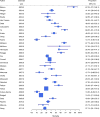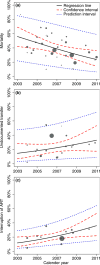Outcomes of HIV-positive patients lost to follow-up in African treatment programmes
- PMID: 28102610
- PMCID: PMC5580236
- DOI: 10.1111/tmi.12843
Outcomes of HIV-positive patients lost to follow-up in African treatment programmes
Abstract
Objective: The retention of patients on antiretroviral therapy (ART) is key to achieving global targets in response to the HIV epidemic. Loss to follow-up (LTFU) can be substantial, with unknown outcomes for patients lost to ART programmes. We examined changes in outcomes of patients LTFU over calendar time, assessed associations with other study and programme characteristics and investigated the relative success of different tracing methods.
Methods: We performed a systematic review and logistic random-effects meta-regression analysis of studies that traced adults or children who started ART and were LTFU in sub-Saharan African treatment programmes. The primary outcome was mortality, and secondary outcomes were undocumented transfer to another programme, treatment interruption and the success of tracing attempts.
Results: We included 32 eligible studies from 12 countries in sub-Saharan Africa: 20 365 patients LTFU were traced, and 15 708 patients (77.1%) were found. Compared to telephone calls, tracing that included home visits increased the probability of success: the adjusted odds ratio (aOR) was 9.35 (95% confidence interval [CI] 1.85-47.31). The risk of death declined over calendar time (aOR per 1-year increase 0.86, 95% CI 0.78-0.95), whereas undocumented transfers (aOR 1.13, 95% CI 0.96-1.34) and treatment interruptions (aOR 1.31, 95% CI 1.18-1.45) tended to increase. Mortality was lower in urban than in rural areas (aOR 0.59, 95% CI 0.36-0.98), but there was no difference in mortality between adults and children. The CD4 cell count at the start of ART increased over time.
Conclusions: Mortality among HIV-positive patients who started ART in sub-Saharan Africa, were lost to programmes and were successfully traced has declined substantially during the scale-up of ART, probably driven by less severe immunodeficiency at the start of therapy.
Keywords: VIH; Afrique subsaharienne; HIV; antiretroviral therapy; loss to follow-up; mortalidad; mortality; mortalité; perte au suivi; pérdida durante el seguimiento; sub-Saharan Africa; terapia antirretroviral; thérapie antirétrovirale; África subsahariana.
© 2017 John Wiley & Sons Ltd.
Figures



References
-
- UNAIDS. Global AIDS Update 2016. Geneva. 2016 (Available from: http://www.unaids.org/sites/default/files/media_asset/global-AIDS-update...) [ 31 May 2016]
-
- UNAIDS. ‘15 by 15’ – a global target achieved. 2015 (Available from: http://www.unaids.org/en/resources/documents/2015/15_by_15_a_global_targ...) [1 May 2016]
-
- Joint United Nations Programme on HIV/AIDS (UNAIDS) 90-90-90. An ambitious treatment target to help end the AIDS epidemic. 2014 (Available from: http://www.unaids.org/sites/default/files/media_asset/90-90-90_en_0.pdf) [5 April 2015]
Publication types
MeSH terms
Substances
Grants and funding
LinkOut - more resources
Full Text Sources
Other Literature Sources
Medical
Research Materials

